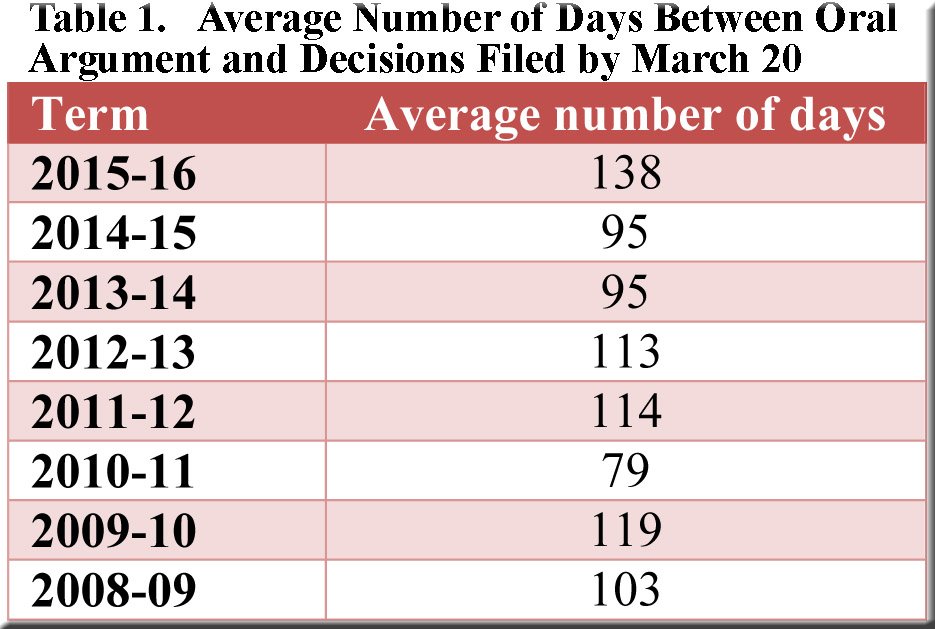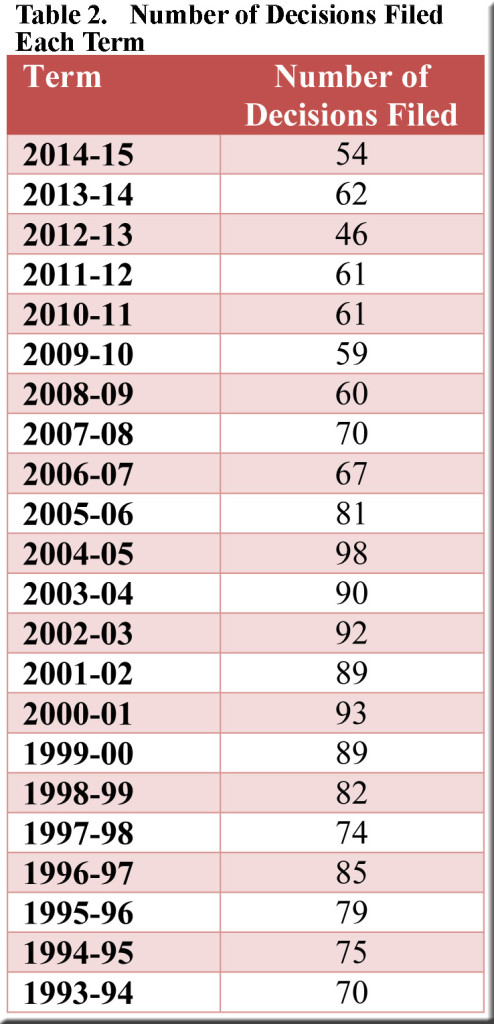Last September, in an unusual comment appended to an order granting review in State v. Salinas, Justice Abrahamson voiced concern about the cases appearing on the court’s agenda for the 2015-16 term. Although the term was just underway, she cautioned that (1) the justices would discover in the months to come that they had accepted an abnormally small number of cases, and (2) a disturbingly large share of this meager case load stemmed from per curiam decisions by the court of appeals.
Six months later, in mid-March, we have a more complete picture of the court’s workload, which permits an assessment of the two alarms sounded by Justice Abrahamson. Turning first to the issue of the volume of cases, the current court has been processing them at a slower rate than in recent years (see Table 1)—an early indication that the total number of decisions for the term will indeed be low.[1]
(click on the tables to enlarge them)
To be sure, some previous terms have witnessed avalanches of decisions as late as June or July, which might suggest that caution is in order when estimating the court’s output with over four months remaining before summer’s end. In 2012-13, for example, the court had filed only 22 decisions as late as the beginning of July—before adding 24 more to the total by the end of the month. However, nothing remotely comparable could occur in 2016. Although the court may well quicken its pace during the remainder of the term, there are so few cases left in the pipeline that even if the justices filed decisions in all of them (which is unlikely), the total could not exceed 50.
More specifically, in addition to the 13 decisions already filed this term, oral argument has been completed in 19 others. Decisions will almost certainly be filed in these cases before the end of the term, bringing our total to 32 decisions.
In addition, oral argument has been scheduled for 12 more cases on various days between February 19 and April 7. Assuming that the court will work at a faster pace in the months to come, or toil well into August, we may add all 12 cases to our previous total of 32.
At this point, having identified 44 cases that should yield decisions during the 2015-16 term, we find that the well is nearly dry. Response briefs have been filed in Wisconsin Carry, Inc. v. City of Madison; Seifert v. Balink; and Democratic Party of Wisconsin v. Wisconsin Dept. of Justice, and one or more of these cases could join the total of 44 decisions. Beyond that, though, I have found only three other cases on the calendar, and in all three only the first brief has been filed.[2]
It seems plausible, then, that the court will not reach 50 decisions this term—perhaps closing the books at around 46, its total for 2012-13 and its low point over the past 22 terms. Thus, although the yield for 2015-16 will not plunge far below that of all previous terms, it will certainly be at the extreme (low) end of a broad range whose other terminus recalls a time, scarcely more than ten years ago, when the court filed roughly twice as many decisions as the total anticipated for 2015-16 (see Table 2).[3]
Meanwhile, there remains the matter of Justice Abrahamson’s anxiety over the share of cases reaching the supreme court in the form of per curiam decisions from the court of appeals. In October, 2015, shortly after she raised the issue, a SCOWstats post examined the 28 cases then on the court’s calendar and found that 25% of them had been per curiam decisions—a considerably higher percentage than in any of the 20 previous terms.
The issue appeared of consequence to Justice Abrahamson because, she maintained, per curiam decisions “do not involve ‘new or unsettled questions of general importance’” and therefore are not likely to merit review. She concluded by wondering if the justices had rejected too many worthy cases and then found themselves accepting undeserving cases in order to populate their depleted agenda.
Since that time, the number of cases on the court’s agenda has reached the point where we can calculate for the entire term the percentage that arrived as per curiam decisions from the court of appeals. For those who share Justice Abrahamson’s unease, it will be troubling to learn that the share has not decreased at all—remaining at a quarter of all cases under review (26%, 13 of 50 cases).
[1] The table covers all of the terms in which the current justices (apart from Justice Rebecca Bradley) have served together. It does not include rulings that review had been improvidently granted, but it does encompass per curiam decisions, one of which was filed during the present term (New Richmond News v. City of New Richmond). Voluntary dismissals were granted in 2015-16 in Attic Angel v. City of Madison and Sorenson v. Building Service Industrial Sales, and neither is included in these calculations.
[2] The three cases are: State v. Maday; State v. Weber; and Brenner v. National Casualty Company.
[3] As in Table 1, these figures include per curiam decisions but omit occasional rulings that review had been improvidently granted.


Speak Your Mind